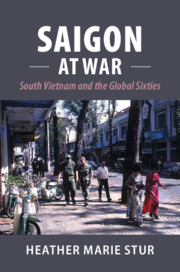Book contents
- Saigon at War
- Cambridge Studies in US Foreign Relations
- Saigon at War
- Copyright page
- Dedication
- Contents
- Figures
- Acknowledgments
- Introduction
- 1 The Heart of South Vietnam
- 2 A Tradition of Activism
- 3 South Vietnam’s Sixties Youth
- 4 South Vietnam and the World
- 5 Building Connections between the People and the Government
- 6 Saigon after Tet
- 7 The Catholic Opposition and Political Repression
- 8 Saigon in the Seventies
- Conclusion
- Select Bibliography
- Index
2 - A Tradition of Activism
Published online by Cambridge University Press: 15 May 2020
- Saigon at War
- Cambridge Studies in US Foreign Relations
- Saigon at War
- Copyright page
- Dedication
- Contents
- Figures
- Acknowledgments
- Introduction
- 1 The Heart of South Vietnam
- 2 A Tradition of Activism
- 3 South Vietnam’s Sixties Youth
- 4 South Vietnam and the World
- 5 Building Connections between the People and the Government
- 6 Saigon after Tet
- 7 The Catholic Opposition and Political Repression
- 8 Saigon in the Seventies
- Conclusion
- Select Bibliography
- Index
Summary
At a dinner party in early 1965, a group of Saigon elites decided to submit a cease-fire petition to the government of South Vietnam. The party was held in the Saigon suburb of Gia Định, at the villa of forty-two-year-old Trương Như Tãng, director of Hiệp Hòa sugar company. The attendees recognized their privilege, that, as “educated patriots and industrialists,” they were at the top of Saigon society. They lived the good life but believed it should not be just for them. Twenty years of war had brought so much sorrow to the Vietnamese people that it was now time to figure out how to end the bloodshed and bring lasting stability to Vietnam. The group assembled at the dinner party included doctors, lawyers, engineers, professors, wealthy industrialists, and government officials. Nguyen Long, a lawyer who had been active in the peace movement of the 1950s and whose son had joined the National Liberation Front in 1962, led the discussion. In 1964, Long had founded the Movement for People’s Self-Determination, and most of the people at the dinner party were members.1 A Catholic in the group noted that Pope Paul VI had sent a message to bishops and priests throughout the world urging peace, an encouraging bit of news as they thought about how they might shape Vietnam’s future.2
- Type
- Chapter
- Information
- Saigon at WarSouth Vietnam and the Global Sixties, pp. 52 - 76Publisher: Cambridge University PressPrint publication year: 2020



